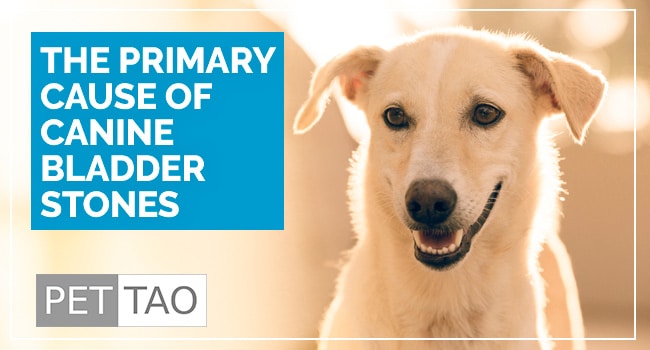Canine bladder stones contain primarily organic or inorganic crystalloid and a much smaller amount of organic matrix.
Supersaturation of Minerals in the Urine
When urine becomes supersaturated with minerals, minerals can precipitate and individual crystals/stones might be observed in the urine.
Supersaturation of urine with minerals and crystalloids depends on the interaction of dozens of crystalloids formed by common mineral elements in the urine-derived from the amount of each solute ingested and excreted in the volume of urine produced.
Diet and urine volume are the most important factors in stone development.
Chronic Low-Grade Dehydration
Dehydration leads to increased urine concentration and increased mineral concentration.
Dry dog foods with inadequate water supply facilitate dehydration because the amount of water required to digest a dry dog food is significant.
Water is pulled out of the cells to aid the digestive process subsequently dehydrating your dog.
Genetics
Some dogs form stones while others do not.
We don’t really know why.
Smaller dogs are generally more likely to develop stones, most likely due to smaller bladder size.
Smaller dogs such as the Shih-Tzu, Poodle, Schnauzer, and Dachshund are more likely to develop canine bladder stones or kidney stones.
Urine pH
Urinary pH is a figure expressing the acidity or alkalinity of the urine and determines whether or not urinary constituents/minerals will stay dissolved or precipitate (become solid).
Different types of stones precipitate depending on pH and a variety of other factors.
Struvite, calcium carbonate, and calcium phosphate precipitate in alkaline urine; cysteine, uric acid, and silica precipitate in acidic urine.
Canine Urinary Tract Infection
Bacterial infections tend to increase the pH making the urine more alkaline.
Certain bacteria such as Staph and Proteus produce an enzyme called urease.
Urease breaks down urinary urea into ammonium ions thereby increasing urinary pH.
If the conditions are right, canine bladder stones may precipitate.
E. Coli is another common bacterial pathogen noted for increasing both urination and drinking.
Canine Bladder Dysfunction
Basically, the bladder suffers from a local immune system failure. Immune failure predisposes the bladder to urinary tract infections.
Also, many dogs fail to empty the bladder properly and completely, leading to a residual repository of bladder debris.
Knowing the causes gives you the knowledge and power to avoid the causes and to keep your pet from suffering from dog bladder stones.
Looking for more ways to improve your pet’s health and wellness?
More Powerful Tools to Help Your Dog’s Urinary Tract & Bladder Challenges
There are many quick and easy changes you can make at home to help you give your dog an edge on easing urinary tract challenges.
- Learn more about dog bladder and kidney stone health challenges.
- Provide bladder support. PET | TAO Soothe Bladder is a blend of Eastern herbs and Western supplements working together to soothe your dog’s bladder and urinary tract..
- Consider a Cooling Diet. PET | TAO’s Chill cools inflammation caused by infection. Make sure to discuss any dietary changes with your holistic vet.
- Try PET | TAO Freeze Dried Beef Kidney Treats. According to TCVM, kidney controls kidney, bladder, and urinary tract functions. As few as 5-6 treats per day can make a huge difference in your urinary tract and bladder health!
- Learn more about TCVM Herbal Remedies. Chinese medicine offers many amazing natural solutions for canine bladder and urinary health challenges. A good example is:








